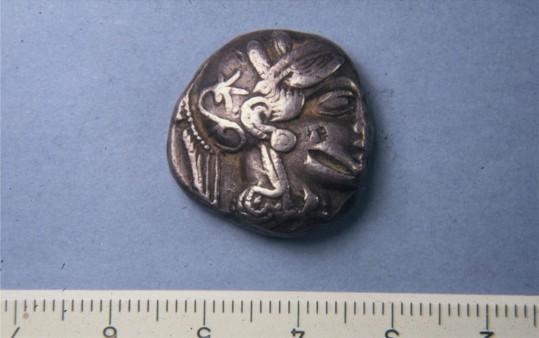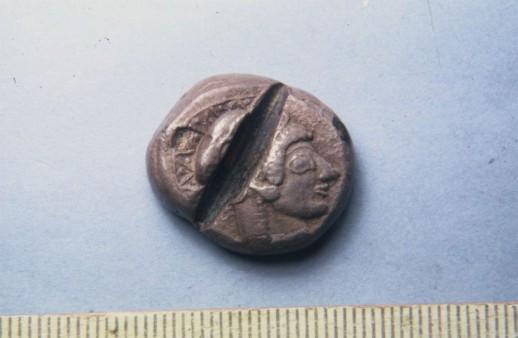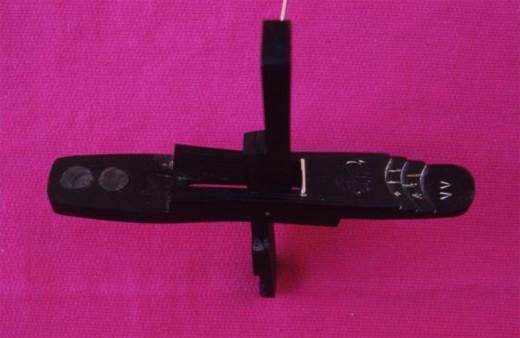PART.2
All the above further support the theory that there definitely must have been an empirical method for quality control. One of the possible ways would have been the comparison between the colour of the finished alloy and that of a series of standard samples. The author of this paper cast a series of bronze (krateroma) samples which had a 2% difference in tin content. With this available series, he compared an unknown sample with the former ones and the comparison was actually successful. It should be noted that if there was fraud, it would not have been of the order of 1 to 2% (owing to the casting process) but greater than 3 to 4%.
Finally, it is interesting that the last two lines of the inscription refer to the names of both the project’s contractor and more importantly to that of the guarantor who would monitor the whole construction process as well as paying the guarantee for the proper carrying out of the order.
Through his extensive research, the author concludes that, in antiquity, there was quality control not only of metals but of all marketable products. Such an example is wine that was watered down (κεκραμένον) when drunk at symposiums. When sold, however, it had to be neat and according to the law of the fraudulent watering of wine («ύδατος της παραχύσεως»), the fine paid by the merchant was a very heavy one if the product was adulterated.
Last it is worth mentioning the authentication of Attic currency which could also be included in its quality control.
The pictured inscribed stele of 375 BC was found in the Stoa of Attalos and refers to the quality control of Attic currency by specialized state inspectors, the assayers.

Fig. 5. Pure silver Athenian coin of the 5th c. BC (Numismatic Museum, Athens).
Figure 5 depicts a genuine 5th c. BC Athenian coin while in figure 6 a counterfeit 6th c. BC coin is shown with a cut right across it. It should be noted that all counterfeit coins, once cut across, were dedicated to the sanctuary of Cybele, Mother of the Gods.

Fig. 6. Counterfeit 6th c. BC Athenian coin. It is a silver plated copper coin that was cut across as counterfeit by the ancient Greek assayer (Numismatic Museum, Athens).
The method of coinage control
One practical method of control could be achieved by using portable scales like the one in figure 7. Of course, the pictured scales are not ancient but belong to the Ottoman period. The author however believes that similar scales could have been used in antiquity.

Fig. 7. Small portable scales used in the period of the Ottoman Empire to ensure the authenticity of silver coins.
As shown in figure 7, counterweights were incorporated in one of its sections while in the other were slots of a particular diameter and depth where the coins to be tested would be placed. In this way:
a) The coin’s mass and dimensions could be checked.
b) If the coin was the proper weight, then it was considered authentic.
c) If the coin being tested was lighter because it was a silver plated copper coin, or heavier if it was of silver plated lead, it had to be considered as counterfeit. In that case, it was cut right across by the assayer (fig. 6) to render it unusable and then it was confiscated.
Apart from the method just mentioned, however, according to an assayer currently employed by the Bank of Greece, the authenticity control could be based on a procedure using the three senses: namely sight, touch and sound.
So this is what is done by an experienced assayer:
a) He very carefully observes the coin, whether silver or gold, b) He feels it with his very sensitive fingers, c) holding it in his palm, he estimates its weight and finally he lets it fall on a hard surface and listens to the sound it makes. As I was told by other specialists in the field, such as jewellers, by this method they can easily authenticate a gold or silver coin.
It is worth mentioning that in his play “The Frogs” Aristophanes describes the sound of authentic coins, when they strike a hard surface, as «κεκωδωνισμένα» meaning proven authentic by their ringing sound. Therefore, by combining his senses, an experienced assayer could check with certainty the authenticity of Attic silver currency. When, however, in the slightest doubt, ancient Greek assayers could combine the use of portable scales with the previously mentioned method of the three senses.
Bibliography
Βαρουφάκης Γ., Αρχαία Ελλάδα και Ποιότητα. Η ιστορία και ο έλεγχος των υλικών που σημάδεψαν τον ελληνικό πολιτισμό, εκδ. Αίολος, 1996.